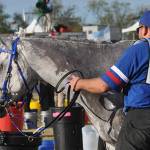Genetic Elements May Hold Secret of Success in Endurance Horses

Small units of genetic material called circulating microRNAs (ci-miRNA) may prove a valuable tool in the design of training programs for athletic horses, ultimately producing fitter, healthier horses that are more likely to complete endurance competitions.
Over the last several years, endurance competitions have increased dramatically in popularity. Horses participating in long-distance events are susceptible to dehydration, electrolyte abnormalities, and heat stress, all of which may be life-threatening if not addressed. Clinically, these events can lead to myopathies, including tying-up, diaphragmatic flutter (thumps), and cardiac arrhythmias. Lameness may also develop during a competition, prompting elimination.
“Horses participating in intense tests of stamina, such as endurance racing, require special training and nutritional support so their bodies can adapt to the stress,” explained Catherine Whitehouse, M.S., a Kentucky Equine Research nutritionist. As an example, endurance horses require electrolyte supplements to replace those minerals lost in sweat during long rides.
Researchers recently evaluated ci-miRNAs in human athletes as potential biomarkers for athletic performance. To determine if these genetic elements can provide clues regarding adaptation to exercise in horses, blood samples were collected from 18 endurance horses. Ten of those horses successfully completed the competition, while the remaining eight were eliminated from competition. Researchers isolated ci-miRNAs from blood samples either at the end of the competition or at time of elimination, and they identified ci-miRNAs that differed between the two groups of horses.
Genes affected by ci-miRNA levels were identified. Those genes were involved in:
- Myogenesis (muscle development);
- Cardiac and skeletal muscle remodeling;
- Angiogenesis (formation of new blood vessels); and
- Ventricular contractility of the heart.
“This was only a preliminary study using a small number of horses, but further research could help identify cellular mechanisms that may indicate poor metabolic adaptation to training. In turn, more effective training programs could be established, improving the health and welfare of competitive horses, including minimizing eliminations,” summarized Whitehouse.
“Current training protocols rely on a combination of subjective and objective measures of performance and recovery in response to speed, distance traveled, and heart rate. In some cases, blood lactate levels can also be used,” she added.
As a reminder, Whitehouse mentioned, “Even successful, well-trained horses need high-quality electrolyte supplementation as these specific minerals—sodium, potassium, and chloride—play a major role in performance, stamina, and recovery.”
*Cappelli, K., S. Mecocci, S. Capomaccio, F. Beccati, A.R. Palumbo, A. Tognoloni, M. Pepe, and E. Chiaradia. 2021. Circulating transcriptional profile modulation in response to metabolic unbalance due to long-term exercise in equine athletes: a pilot study. Genes 12:1965.








